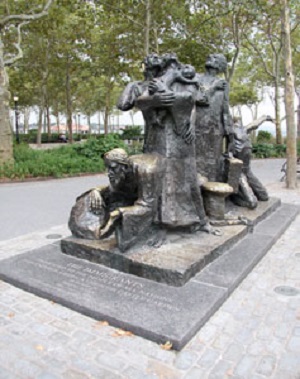
Courtesy of Brian Snelson through Flickr's Creative Commons
Castle Clinton in West Battery Park at the southern end of New York City was originally a defensive post intended to protect the city from the British, but it has also had a rich history as an entertainment and educational venue and as an immigration center that welcomed people from many nations to the United States. As a unit of the National Park System, Castle Clinton National Monument still welcomes visitors to experience a 19th century fortification, catch a ferry to Ellis Island and the Statue of Liberty, and enjoy other activities at the site on New York Harbor.
As tensions grew between the Americans and the British during the early 1800s, the City of New York recognized the need for a defense system to shield its harbor against possible attacks from enemy fleets. The city built a number of forts on the Hudson and East rivers to strengthen New York’s coastal defenses as the War of 1812 grew near, including Castle Clinton (known then as West Battery). Completed in 1811, the circular reddish brownstone fort stood on a manmade island off the southernmost point of Manhattan Island. When the war broke out the following year, Castle Clinton was ready to guard the city and test its 28 guns; however, despite its readiness to defend New York’s harbor, West Battery never engaged in battle or fired a single shot against British fleets.
When the war ended in 1815, New York City continued to use West Battery as the Third District’s Military Headquarters, and in 1817, New Yorkers renamed the fort Castle Clinton in honor of the city’s wartime mayor, Dewitt Clinton. As the city began to evolve into a metropolis and cultural center, the people of New York no longer saw a need to use Castle Clinton for military purposes. In 1824, Castle Clinton became Castle Garden, one of the city’s most popular entertainment centers for 25 years. At Castle Garden, New Yorkers could eat in a restaurant, watch fireworks displays, listen to concerts, enjoy the theater, attend the opera, and witness scientific wonders like Samuel F. B. Morse’s demonstration of the telegraph in 1842.
In the mid-1850s as the number of immigrants entering the United States increased, New York City ceased to use Castle Garden for entertainment, and the State of New York began using it as a depot to welcome the growing number of immigrants. By 1855, Castle Clinton had become the principal reception center for immigrants, processing the entry of eight million people into the United States before its closure 35 years later. Ellis Island opened its doors in 1892. Although Ellis Island became New York’s symbol for immigration, Castle Clinton continues to be significant for the role it played in opening the door to newcomers from around the world who have had a profound influence on the history and culture of New York City and the nation.
After Ellis Island replaced Castle Clinton as the principal receiving center for immigrants, the City of New York responded to its citizens' growing interest in the natural sciences by converting Castle Clinton into the New York Aquarium in 1896. On opening day, more than 30,000 people came to gaze at the different species from the world’s oceans on display in the aquarium. For the next 45 years, Castle Clinton was a popular attraction, as people flocked to visit the aquarium, especially enjoying their favorite display, the West Indian seal. The aquarium closed in 1941, and after the city moved its creatures to the Bronx Zoo and Coney Island, the future of Castle Clinton for the first time seemed uncertain. The city planned to demolish Castle Clinton to make way for the construction of the Brooklyn-Battery Tunnel, but citizens concerned about the significance of Castle Clinton helped save the historic fort, which was recognized as a National Monument in 1946.
Today, Castle Clinton is a museum restored to its original design as a fortification. It is also the location of the ticket office for the ferry to the Statue of Liberty and Ellis Island continuing to connect visitors to the city’s and the nation's rich immigrant history. Visitors can also attend concerts and participate in outdoor activities at the site.
Castle Clinton National Monument, a unit of the National Park System, is located at the southern tip of Manhattan’s Battery Park in New York, NY. Click here for the National Register of Historic Places file: text and photos. The Monument is open daily from 8:30am to 5:00pm, and closes on Christmas Day. Admission to Castle Clinton National Monument is free. Self guided and ranger-led tours are available. There are fees for Ellis Island and the Statue of Liberty ferries. For more information, visit the National Park Service Castle Clinton National Monument website or call 212-344-7220.
Castle Clinton National Monument has also been documented by the National Park Service’s Historic American Buildings Survey.
Last updated: August 8, 2017
